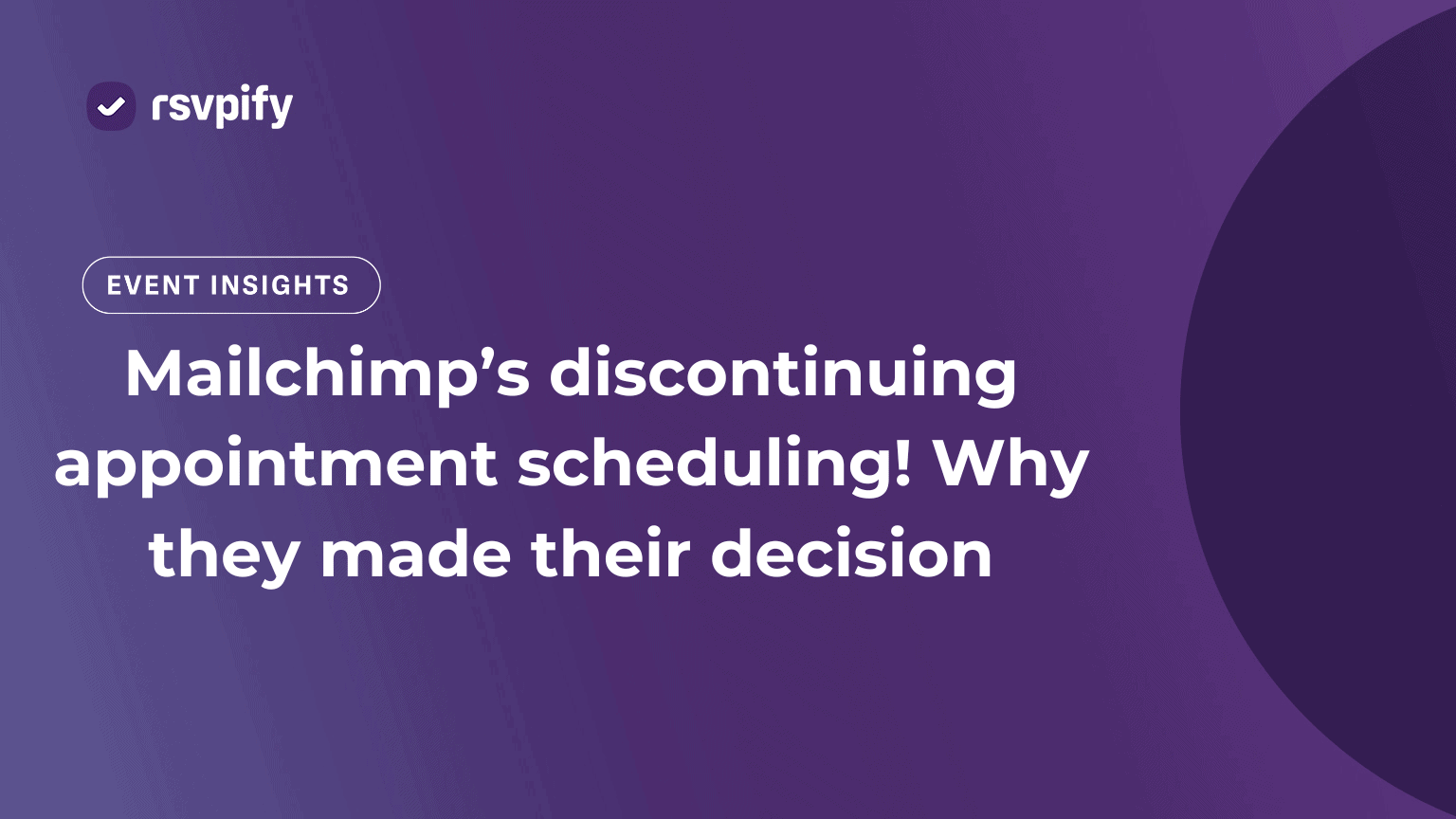04 Dec

Why Mailchimp would end their appointment booking software tools
In a surprise move to its many users, Mailchimp announced recently via user communication channels that it will be discontinuing its appointment scheduling feature effective February 29, 2024. In an email from the company, Mailchimp explained that the appointment booking software “has been an underused feature across our customer base, and this has made us reconsider how scheduling fits into platform offerings. This is why we’ve made the tough decision to discontinue our Appointment Scheduling feature”.
It’s a move that will certainly cause some backlash among users who have turned to the tool for essential scheduling functions for their businesses, but the decision may be more logical than most realize.
Mailchimp’s humble beginnings
Over two decades of existence, Mailchimp established itself as one of the premier names in marketing and email automation for B2B clients. During its early years, Mailchimp was a paid service, limiting its growth potential as many businesses still relied on more traditional forms of advertising.
Remember, this was an era where Facebook was still largely used by college students, listservs were still the common method of creating digital marketing lists, and smartphones were dominated by Blackberry and lacked the tools currently available to digital marketers (like push notifications or app-centric marketing techniques). Spam emails were a common nuisance, and existing competitors like Constant Contact already controlled large shares of the email marketing space.
However, a series of decisions in the late 2000s by leadership began a different trajectory, and in a year Mailchimp had had experienced 6x growth in users and emerged as part of the post-recession tech boom of high-growth companies. By 2019, the platform was hosting over 600 million emails sent every 2 days by clients and users. What changed?
How Mailchimp climbed to the top of the email marketing pyramid
The core of Mailchimp’s value proposition was its ability to automate email marketing for businesses; offering cost savings, advanced analytics capabilities, and outreach potential for smaller and mid-size businesses that allowed them to compete with more resourced competitors. However, others like Constant Contact could offer this too. What made Mailchimp different?
In an interview with the New York Times, founder Ben Chestnut cited “a proximity to its customers that its competitors lacked” as a reason for its success. While the founders have cited Mailchimp’s beginnings as a small business itself as key to connecting successfully with a broader user base, there are a few concrete decisions the company made that provide clear insights into some of the growth strategies that were employed:
- Brand differentiation: Think Freddie, the winking chimp that’s now a widely recognizable symbol of the company. Playful and creative marketing messaging helped Mailchimp stand out from more formal and traditional competitors who focused on professional tones and features in their own marketing.
- Introducing a freemium model: A paid service until 2009, Mailchimp’s switch to a freemium user model triggered immediate results. In the year after the company shifted models, the user base grew by 6x.
- User focus: This is perhaps the most interesting in understanding why Mailchimp’s decision to wind down appointment scheduling would surprise their users. Mailchimp (as evidenced through initiatives and interviews with company decision-makers over the years) made improving user experience and tailoring new features to their needs a core component of its growth strategy in its second decade of operations.
Why a company focused on user experience would remove a core use case
Given how user satisfaction has driven much of Mailchimp’s success (to the tune of a $12 billion acquisition by Intuit in 2021 after years of rejecting offers), why would the company suddenly remove a feature? The company was actually quite clear in telling users that its appointment booking software “has been an underused feature across our customer base, and this has made us reconsider how scheduling fits into platform offerings.” In other words, while appointment scheduling might be attractive to a group of core users, the reality behind the scenes must tell another story.
Companies face these difficult decisions more often than most users realize. Given the effort and investment needed to develop a complex tool like appointment scheduling for a diverse user base at a major company like Mailchimp, there’s a sunk cost involved when making a decision to scrap a developed feature. Developers are needed for the actual features, promotional efforts for building awareness for the feature’s release, and customer support services to support the user learning curve – all of which require labor hours and spend on behalf of the company.
Aside from the actual cost of those hours, companies are often shifting people and resources from a different division to the new feature, meaning other core features lose the same attention. This means that by choosing to make a decision like this, Mailchimp was choosing to write off a significant amount of internal work due to concerns about the value of continued investment in appointment booking software. Additionally, there’s always the fear of a public backlash (especially on social media spaces like LinkedIn where Mailchimp B2B users are most active) and surrendering an area of potential growth to the competition.
The impact of Mailchimp’s decision
At a certain point Mailchimp’s internal analytics must have clearly shown that any benefits for user acquisition or upgrades to premium plans were being outweighed by the cost needed to maintain appointment scheduling. Given the Intuit acquisition is still relatively recent history, this may have been a case of new leadership reassessing a previous strategic decision.
It also may just be a sign of increased competition (and related increased costs for competing) thanks to other newer appointment scheduling-specific companies like Calendly. Or, other growth initiatives (either in expanding existing features or potential features still in development) simply showed more promise for attracting new users or preventing churn from existing ones.
Whatever the reasoning behind the choice, while users may be frustrated or dismayed by the decision to remove a feature they relied on (especially for “super users” who may now be scrambling for a new appointment scheduling solution before next February), the truth is that decisions like this are fairly common and logical for companies evolving their growth strategies year after year. While Mailchimp will naturally keep their internal data and logic for their decision under wraps, it’s clear that the company has concluded that other core features should take precedent for future investment and growth potential. For users who relied on Mailchimp appointment scheduling, it’s simply time to look elsewhere.
Adam Hausman co-founded RSVPify in 2013 and has been passionate about event tech and ticketing software ever since. Also founder of Greenlight Growth Marketing, he holds degrees from Indiana University (BA English/Psychology 2008) and the University of Illinois-Chicago (M.Ed. Secondary Education 2012). He lives in Maine with his wife, 2 kids, and 2 annoying cats.










Adam Hausman